Site NE5
Property: Rutherglen Research Institute.
Paddock Number: 29.
Australian Soil Classification: Sodic, Mesotrophic, Yellow DERMOSOL
Northcote Factual Key: G 2.23
Great Soil Group: No suitable group.
General Landscape Description: Lower slope of a gently undulating rise (2%).
Soil Mapping Unit: Stillards Loam.
Native Vegetation: The original vegetation includes Yellow Box (E.melliodora).
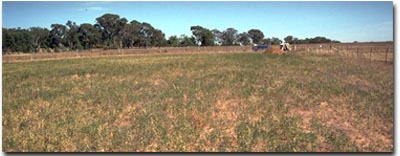 Site NE5 Landscape |
Soil Profile Morphology:
Surface Soil
| A11 | 0-10 cm | Dark brown (7.5YR3/4); light fine sandy clay loam; hardsetting; weakly structured; earthy fabric; weak consistence dry; contains a trace (1%) amount of quartz gravel; pH 6.4; abrupt change to: | 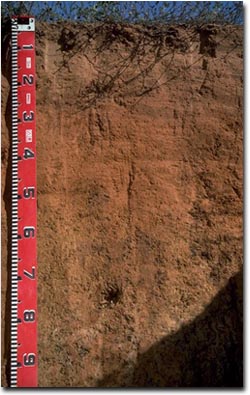 Site NE5 Profile |
| A12 | 10-25 cm | Yellowish red (5YR4/6); fine sandy clay loam; massive; earthy fabric; strong consistence dry; contains a trace (1%) amount of quartz gravel; pH 5.3; clear and wavy change to: | |
| Subsoil | |||
| B1 | 25-50 cm | Yellowish red (5YR5/8); clay loam, fine sandy (becoming light clay with depth); weakly structured; earthy fabric; firm consistence dry; contains a few (7%) ferromanganiferous nodules, as well as a few (3%) angular quartz fragments (2-5 mm size); pH 6.5; gradual and wavy change to: | |
| B21 | 50-75 cm | Brownish yellow (10YR6/6) with red (2.5YR4/8) mottles; light medium clay; moderate medium blocky structure; strong consistence dry; contains a few (10%) manganese stains in patches, as well as a few (3%) quartz fragments (2-5 mm size); pH 7.1; gradual and wavy change to: | |
| B22 | 75-110 cm | Light yellowish brown (10YR6/4) with red (2.5YR4/8) mottles; light clay; moderate medium polyhedral structure; strong consistence dry; contains a common (10-20%) amount of manganese segregations; pH 6.9; gradual change to: | |
| B23 | 110+ cm | Brownish yellow (10YR6/6); light clay; strong medium polyhedral structure; strong consistence dry; contains a common (10%) amount of manganese segregations; pH 8.5. | |
Key Profile Features:
- A lack of clear or abrupt texture change to the B Horizon i.e. gradual increase in clay content down the profile.
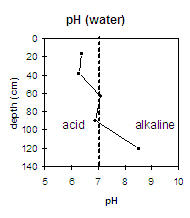 | The surface soil is slightly acid and the subsurface (A2) horizon is strongly acid. The upper subsoil is mainly slightly acid and the deeper subsoil (below 1 metre depth) is moderately alkaline. | 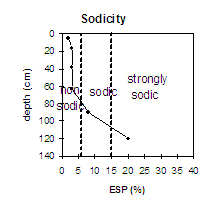 | The upper soil profile is non-sodic. The deeper subsoil (below 1 metre depth) becomes sodic. |
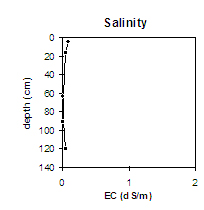 | The level of soluble salts are very low throughout the profile. | 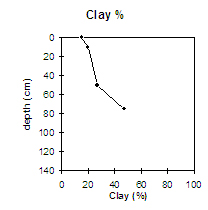 | The clay percentage increases gradually with depth. |
Horizon | Horizon Depth (cm) | pH (water) | pH (CaCl2) | EC 1:5 | Exchangeable Cations | Exchangeable Aluminium mg/kg | Field Capacity pF 2.5 | Wilting Point pF 4.2 | Coarse Sand (0.2 - 2.0 mm) | Fine Sand (0.02 -0.2 mm) | Silt (0.002 -0.02 mm) | Clay (<0.002 mm) | |||
Ca | Mg | K | Na | ||||||||||||
meq/100g | |||||||||||||||
A11 | 0-10 | 6.4 | 5.8 | 0.09 | 4.4 | 0.8 | 0.7 | <0.1 | 20 | 9 | 11 | 57 | 14 | 15 | |
A12 | 10-25 | 5.3 | 4.5 | 0.05 | 2.2 | 0.5 | 0.6 | <0.1 | 24 | 19 | 9 | 13 | 51 | 17 | 20 |
B1 | 25-50 | 6.5 | 5.7 | <0.05 | 4.3 | 1.5 | 0.5 | 0.1 | 12 | 46 | 15 | 27 | |||
B21 | 50-75 | 7.1 | 6 | <0.05 | 4 | 2.4 | 0.3 | 0.2 | 24 | 14 | 6 | 33 | 15 | 47 | |
B22 | 75-110 | 6.9 | 5.5 | <0.05 | 1.7 | 3.1 | 0.3 | 0.4 | |||||||
B23 | 110+ | 8.5 | 6.8 | <0.05 | 3.4 | 5.6 | 0.4 | 2.3 | |||||||
Management Considerations:
Surface (A) Horizons
- The surface (A11) horizon has a high fine sand content (ie. 57%). Organic matter is therefore very important for maintaining aggregation and preventing slaking.
- The upper subsoil is non-sodic and does not disperse and will be relatively well drained. The redder soil colour of the upper B Horizon is also indicative of reasonable drainage conditions.
- The deeper subsoil becomes sodic and dispersive. Deep drainage and root movement will be restricted as a consequence.
- The presence of manganese segregations in the subsoil may have a toxic effect on deep-rooted manganese sensitive plants.
- Disc ploughed in 1971 and ploughed in 1973, 1974 and 1978. Disced and cultivated in 1994.
- Lucerne grown in 1994.


